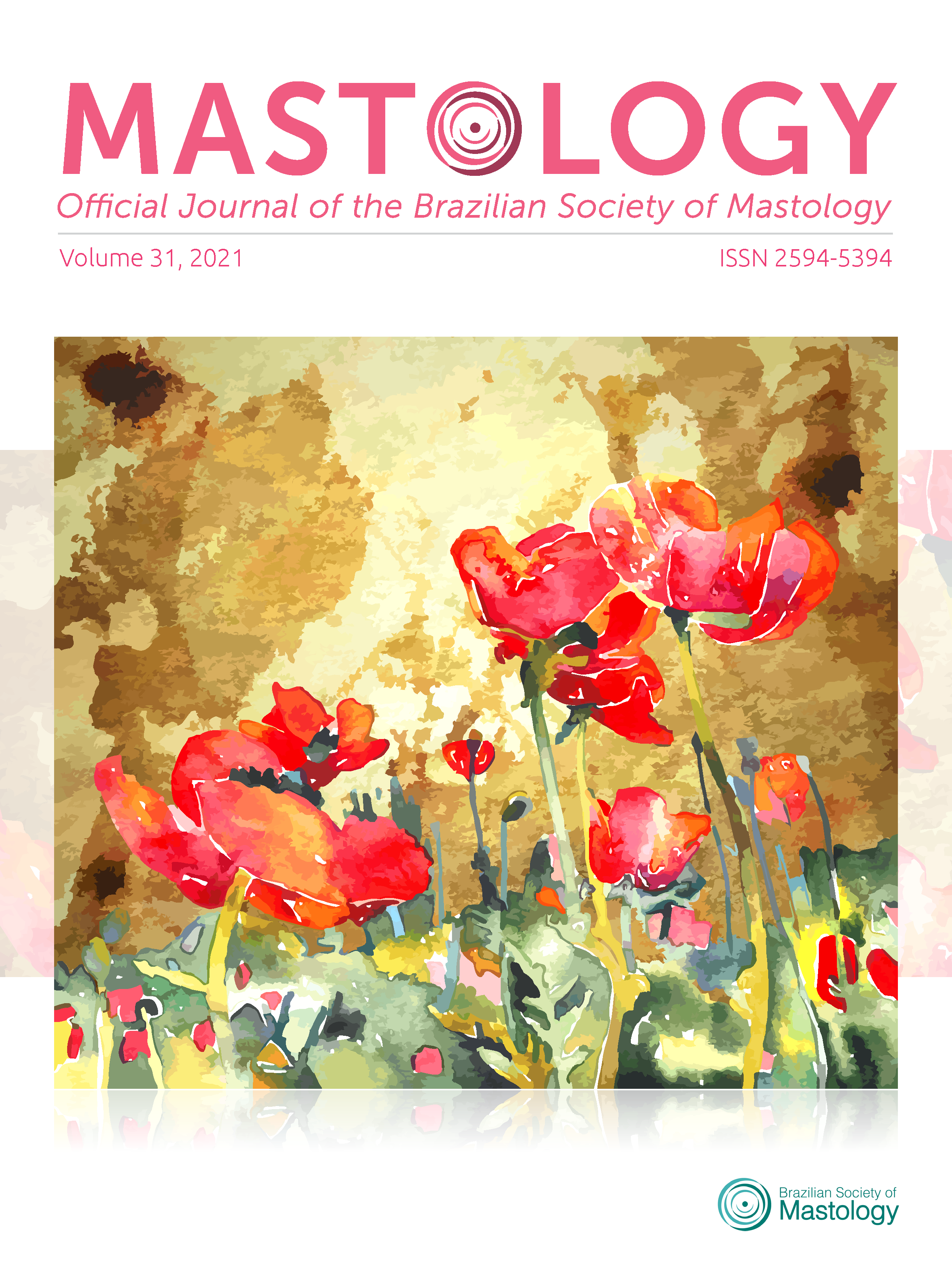Minimally invasive treatment of gynecomastia by ultrasound-guided vacuum-assisted excision
report of a case series
Keywords:
gynecomastia, mammary ultrasonography, interventional ultrasound, needle bipsyAbstract
Introduction: Gynecomastia (GM) is a benign proliferation of glandular breast tissue in men. Some cases need surgical intervention. Traditional open surgery by semicircular inferior periareolar incision is the most common surgical approach. In order to obtain better esthetic results, some alternatives to open surgery have been proposed, such as liposuction, endoscopic mastectomy, and vacuum-assisted excision (VAE). Objective: To describe the technical surgical approach of ultrasound-guided VAE of GM and its results from a case series. Method: This is an evaluation of seven GM cases submitted to ultrasound-guided VAE with a 10G needle using the ENCOR ® BD whole circumference automated breast biopsy system in Redimasto – Redimama, a Brazilian breast center. The result was considered good or satisfactory when it showed minimal remaining gland, good symmetry, no retraction, necrosis, hypertrophic scar, or displacement of the nipple-areola complex. All patients answered a questionnaire to evaluate their satisfaction and perception of the procedure. Results: Seven (7) patients with Simon grade 1 and 2 bilateral GM underwent ultrasound-guided VAE. No case of displacement, necrosis, or retraction of the nipple-areola complex, post-procedure bleeding, infection, skin necrosis, or asymmetry was detected. No patient reported decrease or change in nipple sensation or erection. All patients had bruises and hematomas that spontaneously resolved within 30 days. All results were considered good or excellent by patients and surgeons. Conclusion: Minimally invasive ultrasound-guided VAE is an excellent alternative for the treatment of GM. It is better indicated for Simon grade 1 and 2 GM, with good and excellent esthetic results, small scar, and low rates of nipple and areolar complications. It allows an outpatient procedure with low morbidity (local anesthesia) and fast recovery.
Downloads
References
Kanakis GA, Nordkap L, Bang AK, Calogero AE, Bártfai G, Corona G, et al. EAA clinical practice guidelines-gynecomastia evaluation and management. Andrology. 2019;7(6):778-93. https://doi.org/10.1111/andr.12636
Narula HS, Carlson HE. Gynaecomastia: pathophysiology, diagnosis and treatment. Nat Rev Endrocrinol. 2014;10(11):684-98. https://doi.org/10.1038/nrendo.2014.139
Vojvodic M, Xu FZ, Cai R, Roy M, Fielding JC. Anabolic-androgenic Steroid Use Among Gynecomastia Patients: Prevalence and Relevance to Surgical Management. Ann Plast Surg. 2019;83(3):258-63. https://doi.org/10.1097/SAP.0000000000001850
Simon BE, Hoffman S, Kahn S. Classification and surgical correction of gynecomastia. Plast Reconstr Surg. 1973;51(1):48-52. https://doi.org/10.1097/00006534-197301000-00009
Varlet F, Raia-Barjat T, Bustangi N, Vermersch S, Scalabre A. Treatment of Gynecomastia by Endoscopic Subcutaneous Mastectomy in Adolescents. J Laparoendosc Adv Surg Tech A. 2019;29(8):1073-6. https://doi.org/10.1089/lap.2019.0256
Courtiss EH. Gynecomastia: analysis of 159 patients and current recommendations for treatment. Plast Reconstr Surg. 1987;79(5):740-53. https://doi.org/10.1097/00006534-198705000-00010
Colombo-Benkmann M, Buse B, Stern J, Herfarth C. Indications for and results of surgical therapy for male gynecomastia. Am J Surg. 1999;178(1):60-3. https://doi.org/10.1016/s0002-9610(99)00108-7
Qutob O, Elahi B, Garimella V, Ihsan N, Drew PJ. Minimally invasive excision of gynaecomastia—a novel and effective surgical technique. Ann R Coll Surg Engl. 2010;92(3):198-200. https://doi.org/10.1308/003588410x12628812458815
He Q, Zheng L, Zhuang D, Fan Z, Xi C, Zhou P. Surgical treatment of gynecomastia by vacuum-assisted biopsy device. J Laparoendosc Adv Surg Tech A. 2011;21(5):431-4. https://doi.org/10.1089/lap.2011.0019
Yao Y, Yang Y, Liu J, Wang Y, Zhao Y. Vacuum-assisted minimally invasive surgery. An innovative method for the operative treatment of gynecomastia. Surgery. 2019;166(5):934-9. https://doi.org/10.1016/j.surg.2019.04.032
Wang Y, Wang J, Liu L, Liang W, Qin Y, Zheng Z, et al. Comparison of curative effects between mammotome-assisted minimally invasive resection (MAMIR) and traditional open surgery for gynecomastia in Chinese patients: A prospective clinical study. Breast J. 2019;25(6):1084-9. https://doi.org/10.1111/tbj.13424
Iwuagwu O, Drew P. Vacuum-assisted biopsy device-diagnostic and therapeutic applications in breast surgery. Breast. 2004;13(6):483-7. https://doi.org/10.1016/j.breast.2004.06.004
Mazzarone F. Avaliação da satisfação do resultado de cirurgia plástica [dissertation]. Rio de Janeiro: Fundação Cesgranrio; 2013.
Downloads
Published
How to Cite
Issue
Section
License
Copyright (c) 2021 Henrique Lima Couto, Carolina Nazareth Valadares, Osmar Pellegrini Junior, Tereza Cristina Ferreira de Oliveira, Patricia Martins Gomes El Bacha, Shirley das Graças Ferreira

This work is licensed under a Creative Commons Attribution 4.0 International License.







